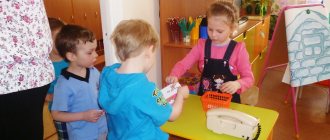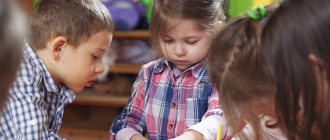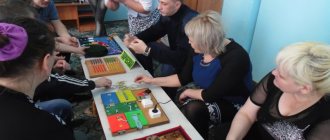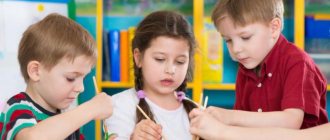Card index of social and communicative development middle group card index (middle group)
Card index of games for social and communicative development in the middle group.
"Name yourself"
Goal: To develop the ability to present oneself to a group of peers.
The child is asked to introduce himself, saying his name as he prefers, as he would like to be called in the group.
“Call me kindly.”
Goal: to cultivate a friendly attitude among children towards each other.
The child is asked to throw a ball or pass a toy to his favorite peer (optional), affectionately calling him by name.
"Magic Chair"
Goal: to cultivate the ability to be affectionate, to activate gentle, affectionate words in children’s speech.
One child sits down, and the rest say kind, affectionate words about him.
"Magic wand".
Goal: continue to develop the ability to be affectionate.
Children stand in a circle. One child passes the stick to the person standing next to him and calls him affectionately.
"Freeze."
Goal: develop listening skills, develop organization.
The point of the game is the teacher’s simple command “Freeze,” which can be heard during children’s activities, in a variety of situations.
"Stream"
Goal: to develop the ability to act together and teach to trust and help those with whom you communicate.
Before the game, the teacher talks with the children about friendship and mutual assistance, about how they can overcome any obstacles. The children stand one after another and hold on to the shoulders of the person in front. In this position they overcome any obstacles.
Go around the lake, crawl under the table, etc.
"Magic wand".
Goal: developing ideas about the capabilities of one’s own and peers.
One names the fairy tale, another its characters, etc.
"Polite Words Store"
Goal: develop goodwill, the ability to establish contact with peers.
Educator: I have polite words on the shelf in my store: greetings (hello, good morning, good afternoon, etc.); affectionate addresses (dear mommy, dear mommy, etc.).
I will offer you various situations, and you buy the right words from me.
Situation. Mom brought apples from the store. You really want to, but mom said you need to wait until lunch.
How do you ask her to give you an apple?
"Body".
Goal: Continue to reinforce polite words.
Children sit around a table on which there is a basket. The teacher turns to the child: “Here’s a box for you, put a polite word in it.”
"That's what grandma is like"
Goal: develop respect for elders, reinforce kind words.
Each child takes turns telling what his grandmother’s name is, and how affectionately you can call her.
"Wonderful bag"
Goal: expanding the volume of vocabulary, developing tactile perception and ideas about the characteristics of objects.
Children take turns recognizing the object by touch, naming it, and taking it out of the bag.
"Good words".
Goal: to develop the ability to use kind words in speech.
Children choose kind words. Show the children a picture of children working. What can you call children who work? (Hardworking, active, kind, noble, etc.)
"Rug of reconciliation."
Goal: develop communication skills and conflict resolution skills.
Coming from a walk, the teacher tells the children that two boys quarreled over a toy. Invites you to sit down opposite each other on the “rug of reconciliation” to find out the cause of the discord and find a way to peacefully resolve the problem. Discuss how to share the toy.
“What to do, what to do?”
Goal: to awaken children’s initiative, independence, intelligence, responsiveness, and willingness to look for the right solution.
Create a situation: there are no paints of certain colors, there is not enough plasticine for modeling. Children look for solutions on their own.
"Package"
Goal: expanding the vocabulary, developing coherent speech.
The child receives a package from Santa Claus and begins to describe his gift without naming or showing it. The item is presented after the children have guessed it.
“This is what Santa Claus is like”
Goal: develop respect, reinforce kind words.
The child tells what gifts Santa Claus brought, how he thanked him, and how you can affectionately call him.
"Without a mask"
Goal: develop the ability to share your feelings, experiences, and construct unfinished sentences.
The teacher says the beginning of the sentence, the children must finish.
What I really want is………….
I especially like it when……………………………
One day I was very frightened by the fact that ………………..
"Day Night"
Goal: develop the ability to collaborate and achieve the desired result.
After the words “The day is coming, everything comes to life,” the participants in the game move chaotically and jump. When the teacher says: “Night comes, everything freezes,” the children freeze in bizarre poses.
“Listen outside the window, outside the door”
Goal: develop auditory attention.
As instructed by the teacher, all children focus their attention on the sounds and rustles of the corridor. Then they take turns listing and explaining what they heard.
"Who better to praise"
Goal: to be able to name the characteristics of animals based on the example of an adult, to develop attention and the ability to describe.
The teacher takes a bear for himself and gives the child a bunny.
And he begins: “I have a bear.” Child: “And I have a hare.” etc.
"Who am I talking about"
Goal: to develop observation skills, the ability to focus on the main features of the described object.
The teacher describes the child sitting in front of him, naming his details of clothing and appearance. For example: “This is a girl, she’s wearing a skirt and blouse, her hair is blond, her bow is red. She loves to play with the Tanya doll."
“That’s what dad is like.”
Goal: develop respect for dad, reinforce kind words.
The child tells what his dad’s name is, how he plays with him, how he affectionately calls him.
“Describe a friend.”
Goal: to develop attentiveness and the ability to describe what you saw.
Children stand with their backs to each other and take turns describing their partner’s hairstyle, clothes, and face. Then the description is compared with the original and a conclusion is drawn about how accurate the child was.
“That’s what mom is like.”
Goal: develop love for mom, reinforce kind words.
Each child takes turns telling what his mother’s name is, how she takes care of him, and how she can be affectionately called.
"What changed?".
Goal: attentiveness and observation necessary for effective communication.
The driver leaves the group. During his absence, several changes are made in the group (in the children's hairstyle, in clothes, you can move to another place), but no more than two or three changes.
"A gift for everyone"
Goal: develop a sense of team, the ability to make friends, make the right choice to cooperate with peers.
The children are given the task: “If you were a wizard and could work miracles, what would you give to all of us now?”
"Why?"
Goal: develop the ability to be friends and be polite.
For example, if a girl is offended, she will cry.
If you accidentally pushed, then……………
You were given a toy, then……………
"Beat the transformation"
Goal: to cultivate trust in each other, a sense of responsibility for the other.
The teacher passes the object (ball, cube) in a circle, calling them by conventional names. Children act with them as if they were objects named by an adult. For example, they pass a ball around in a circle. The presenter calls it “Apple” - the children “wash”, “eat”, “sniff”, etc.
"Toys Alive"
Goal: to form a culture of communication in children.
Educator. You've probably been told or read fairy tales about how toys come to life at night. Please close your eyes and imagine your favorite toy, imagine what it does when it wakes up at night. Introduced? Then I suggest you play the role of your favorite toy. And we’ll try to guess what kind of toy you were depicting.
"Edible - inedible"
Goal: development of auditory attention, development of the ability to highlight the essential features of an object (edibility, animation).
The leader says the word and throws a ball to one of the children and names the object. If edible, the player catches the ball, and if inedible, the player dodges the ball.
"Magic wand".
Goal: to form ideas about the capabilities of one’s own and peers, to consolidate the signs of spring.
Children pass the stick and name the signs of spring.
"Let's say hello."
Goal: to create a psychologically relaxed atmosphere in the group.
The teacher and children talk about different ways of greeting, real and comic. Children are encouraged to greet with their shoulder, back, hand, nose, cheek and come up with their own way of greeting.
"What can happen?".
Goal: develop imagination, strengthen the ability to finish a sentence, and the ability to listen to each other.
What could happen if……….
“All fairy-tale heroes will come to life.”
“The rain will continue to fall.”
Middle group. Junior preschool age. Children 4 - 5 years old
Development of research and experimental activities in children of the middle group as a condition for successful socialization Plan for self-education on the topic: “ Development of research and experimental activities in children of the middle group as a condition for successful socialization ” Chinese saying What I heard, I forgot What I saw I remember What I did, I know Of particular importance for development ...
Abstract of OD for children of the middle group on social and communicative development “Electrical appliances” Game-based learning situation. Form of activity: joint activity of adults and children. Type of activity: gaming, artistic, creative. Program objectives: • Educational: introduce children to electrical appliances, draw attention to the fact that they can be dangerous...
The elements of effective communication include
- desire to interact with others;
- the ability to organize communication - listen to the interlocutor, empathize emotionally, resolve conflict situations;
- knowledge of the norms and rules that must be followed when communicating with others.
The implementation of the tasks of social and communicative development of preschool children is aimed at gaining experience in various types of children's activities .
- Playful activities make the child feel like an equal member of human society. In the game, the child gains confidence in his own abilities, in the ability to get real results.
- Research activity allows the child to independently find a solution or refutation of his own ideas.
- Fine - allows the child, with the help of work and imagination, to get used to the world of adults, get to know it and take part in it.
- Subject-based – satisfies the child’s cognitive interests at a certain period, helps to navigate the world around him.
- Observation enriches the child’s experience, stimulates the development of cognitive interests, gives rise to and strengthens social feelings.
- Communicative (communication) – unites an adult and a child, satisfies the child’s various needs for emotional closeness with an adult, for his support and evaluation.
- Project - activates the child’s independent activity, ensures the unification and integration of different types of activities.
- Constructive – makes it possible to form complex mental actions, creative imagination, and mechanisms for managing one’s own behavior.
Thus, each type of activity contributes to the process of social and communicative development of preschool children.
The specificity of preschool age is that the social development of a child is carried out under the influence of an adult who introduces the child into society. The child cooperates with competent adults; as a member of society, he is included in the system of human relations, where a dialogue of personalities and value systems takes place. The development of patterns and norms of behavior and the search for correct life attitudes occurs in preschoolers in interaction with peers, teachers, and parents.
Before starting classes on the development of communication skills, as well as subsequently, it is important for teachers to diagnose the communicative development of preschoolers. It consists of conducting a conversation with children, observing them as they complete a task, using preschool didactic material. Communicative development is assessed according to three criteria:
- The child’s knowledge of the rules of communication with people.
- How willingly the child communicates.
- The extent to which a child can listen, resolve conflict situations, and how empathic he is.
Each of these three criteria is assessed using a point system, and as a result, communicative development is assessed at one of three levels: high, low or average.
Children aged 2-3 years are just beginning to master communication skills. A good activity option for them would be to role-play a situation involving going on a visit .
Topic: “To the bunny’s birthday.”
Goal: familiarization with the rules and norms established in society.
Equipment: laptop; loudspeakers; recording a song; toy car; bunny toy; toy gift.
Summary of GCD for the middle group Socialization Topic: “Boys and Girls”
Author:
Iskhakova Elza Nazikhovna,
teacher
MBDOU TsRR-d/s No. 81 “Malvina”
Surgut
Goal: Development of children’s ideas about gender role similarities and differences between the images of a boy and a girl.
Software tasks:
1. Teach children to identify the main signs of differences and similarities between boys and girls,
2.Form an adequate idea of your own gender.
3.To consolidate knowledge about the interests and various types of activities of children depending on gender.
4.Improve children’s knowledge about the classification of professions (male, female) with the help of professional supplies.
5. Activate children’s speech activity in the selection of verbs and adjectives.
6.Cultivate in children a friendly and sensitive attitude between girls and boys.
Preliminary work: conversation with boys “Our Defenders”, conversation with girls “Modest and Beautiful Girls”, game “What do dads do”, “What do mothers do?”, reading fiction works by boys and girls, looking at photographs of boys and girls.
Equipment: laptop, song “From what, from what,” flower hint daisy, ball, box with toys (car, blocks, construction set, doll, handbag, dog, ball, gun, rackets), bag with professional supplies - scissors with comb, hacksaw, steering wheel, thread, group photo, fire extinguisher.
Integration:
Educational area “Cognition”: maintain the score within 5.
Educational area “Music”: listening to the work “What are boys made of...”, dance movements to the music.
Educational area “Physical education”: strengthen the ability to catch and throw a ball with both hands.
Educational area “Communication”: activation of verbs and adjectives in children’s vocabulary.
Direct educational activity “Socialization” is carried out with a subgroup of children.
Course of the lesson : Children stand in a circle. The children's song is “What are boys made of?” What are girls made of? What a beautiful song. What is this song about? Yes, about boys and girls. Are there any girls among you? Clap your crayfish girls. What about the boys? Stomp your feet. How are boys different from girls? A magic flower will help us with this. I tear off one petal, and it says “Masha and Sasha.” Girls and boys have different names. What boy names do you know? (children's answers). What are the girls' names? (children's answers). Boys and girls have different names.
Chamomile bloomed in the garden
Snow white shirt
Petals once and twice...
What other differences are there between boys and girls? Let's tear off the second sheet and find out... Clothes. The flower gives us a hint that boys and girls are different in their clothes. What do you guys think? What do boys wear? What about the girls? Girls wear skirts and dresses. And the boys have shirts and shorts. Do girls wear shorts? Yes, they do, but boys wear these clothes more often.
I go up to the flower and tear off the third petal. Game "Sort out the toys." Guys, here's the problem, the toys are mixed up, your task is to pick up the boys' toys in the blue tray, and the girls' toys in the red one. And we’ll leave neutral toys in the box that both boys and girls can play with. Look guys, we are so different, but toys can be common - toys for girls and boys. Well done!
Chamomile bloomed in the meadow
Modest little white flower
What's from the yellow pocket
Dropped a petal.
I tear off the fourth petal. Guys, you each have a mom and dad. What is your mother like? My mother is caring (I show an example) I pass the ball. What kind of mother is yours? (children's answers) When the ball reaches me, I turn to: My dad is smart. What kind of dad is yours? (children’s answers). My mother takes care of flowers at home. What is your mother doing? My dad can fix an outlet at home! What is your dad doing?
I walk up to the flower and tear off the last petal. Game "Wonderful bag". Guys, you need to take turns going to the bag and taking out an item that is necessary for one activity or another. Based on the subject, you must determine which profession belongs to women or men? (female - teacher - group photo, hairdresser - scissors and comb, seamstress - threads and needles; m - carpenter - saw, driver - steering wheel, doctor - syringe).
Guys, boys and girls, you are so different, there are so many differences between you, and yet you also have things in common: names, clothes, toys, professions.
“Certificate of publication in the media” Series A No. 0002273, barcode (receipt No.) 62502669050193 Date of dispatch December 12, 2013
We invite teachers of preschool education in the Tyumen region, Yamal-Nenets Autonomous Okrug and Khanty-Mansi Autonomous Okrug-Yugra to publish their teaching materials: - Pedagogical experience, original programs, teaching aids, presentations for classes, electronic games; — Personally developed notes and scenarios of educational activities, projects, master classes (including videos), forms of work with families and teachers.
Why is it profitable to publish with us?
1. “Kindergartens of the Tyumen Region” is an officially registered specialized media outlet at the federal level. 2. The activities of the editorial office are supported by the Department of Education and Science of the Tyumen Region 3. We issue a “Certificate of Publication” in the media. 4. The document has a unique number, is entered in the register, has the original seal of the editorial office of the online publication and signature. 5. “Certificate of publication” in the media is sent to the author in both paper and electronic versions.
Details >>>
Sample “Certificate of publication of author’s methodological material in the media.”pdf
Share





